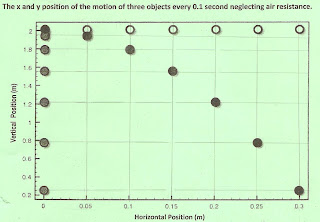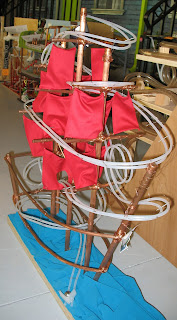Anyway, it's time for another blog. This time it's about the four problems based on Newton's laws of force that we learn in grade 11 physics. First, let's get to the three laws.
Newton thought of three laws to explain how forces work in the world. They are:
-Law of inertia: object will maintain their motion (stationary or moving) unless there's an external force acting on it.
-Relationship between force, mass and acceleration: Force is directly proportional to acceleration, and mass is inversely proportional to acceleration. Therefore, a=F/m.
-For every action, there's a reaction of equal and opposite strength.
Now that we know the three laws, let's get on to the problems:
Equilibrium:
Equilibrium problems usually consist of two forces acting on an object that keeps it stationary. Therefore, the net force would equal to zero. In order to solve the problem, we must list a few assumptions.
-no friction
-no air resistance
-positive areas
-Fnet = 0, a = 0
-rope is weightless
Now, from Newton's second law, we know F = ma. To find the Fx, we do this:
Fx = max
Fx = 0
T1x - T2x = 0
T1x = T2x
T1cosθ = T2cosθ
T1 = T2
With this information, we can solve Fy.
Fy = ma
Fy = 0
-Fg + T1y + T2y = 0
T1y + T2y = Fg
T1sinθ + T2sinθ = mg
Then we can single out any part of the formula, and figure out the missing value.
Incline:
There are two types of inclines, static and kinetics. Static is when the object is not moving, and kinetic is when the object is moving.
They have different assumtions.
Assumptions (Static):
-fs
-Fn is perpendicular to the surface
- a = 0
- positive in the direction of acceleration.
- no air resistance
We would solve like this:
Fx = 0
Fgx - fs = 0
Fgx = fs
mgsinθ = muFn *
Fy = 0
Fn - Fgy = 0
Fn = Fgy
Fn = mgcos θ *
now put the *s together:
mgsinθ = mu(mgcosθ)
mu = sinθ/cosθ
mu = tanθ
and now you can find out what you need.
Assumptions (kinetics):
-fk
-Fn is perpendicular to surface
- ax ≠ 0, ay = 0
- positives in the direction of acceleration
- no air resistance
To solve:
F= ma
Fy = 0
Fn - Fgy = 0
Fn = Fgy
Fn = Fgcosθ
Fn = mgcosθ *
Fx = max
Fgx - fk = max
Fgsinθ - muFn = max
insert * into above
mgsinθ - mumgcosθ = max
And now we can single out and figure out whatever we need.
Pulleys:
Assumtions:
-frictionless pulley and rope
-no air resistance
-multiple Free Body Diagrams
-positives in the direction of acceleration
- T1 = T2
- acceleration of system is the same.
To solve:
F = m1a
Fy = m1ay
m1g-T = m1a
The x components cancel out as there isn't Fx or ax.
F = m2a
Fy = m2ay
T - m2g = m2a
Fx again cancels out for the same reasons.
to find T and a
m1g - T = m1a *
T - m2g = m2a @
From *, T = m1g - m1a #
from @, T = m2a + m2g $
set # = $ m1g - m1a = m2a + m2g
m2a + m1a = m1g - m2g
a(m2 + m1) = m1g - m2g
a = m1g - m2g / m2 + m1
Then we find the a. To find T, sub a into # ( T = m1g - m1a).
Trains:
God I miss my tablet. And PaintoolSai. MS Paint and mouse is just annoying.
Assumptions:
- 3 Free Body Diagrams to find T
- no air resistance
- ay = 0
- cables are weightless
- positive in direction of a
- a is constant
- horizontal
To solve:
F = mta
Fy = 0
Fn - mtg = 0
Fn = mtg *
F = mtax
Fa - f = mtax
Fa - muFn = mta
Fa - muFn/mt = a
and we find the acceleration.
F = ma
Fy = 0
Fn - m3g = 0
Fn = M3g *
F = m3ax
T2 - f3 = m3ax
T2 - mum3g = m3a
T2 = m3a + mu m3g
and we find the T2.
F = ma
Fy = 0
Fn - m2g = 0
Fn = m2g *
F = m2ax
T1 - T2 - f2 = m2ax
T1 - T2 mum2g = max
T1 = m2ax + T2 + mum2g
And we find the T1.
What a handful to do. Lot of them seems repetitive but it'll come in handy in the future when the questions become more complicated, apparently.








